The irresistible glimmering beaches, magnificent historical attractions, gorgeous azure waters make Mahabalipuram one of the most ultimate destinations. This charming coastal town is adorned with centuries old stone carved heritage sites, and is one of the most preferred halt for those who come from Puducherry and Chennai. The streets of Mahabalipuram is dotted with various cafes serving varieties of lip-smacking South Indian cuisines and this beautiful city also quench the thirst of surfing and basking in the sun. So, if you are looking for a holiday to witness the holistic experience then Mahabalipuram is the perfect choice for your vacation.
Dharamraj Cave In Mahabalipuram
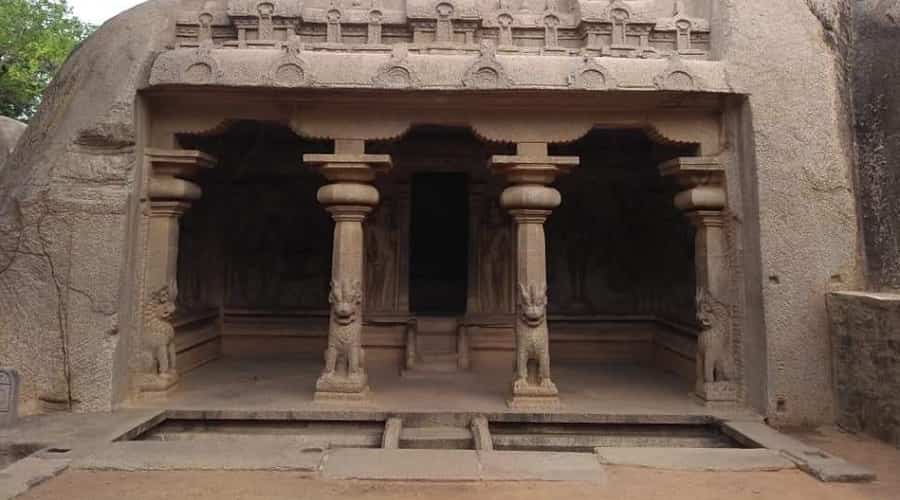
Dharamraj Cave in Mahabalipuram is a very famous temple which has different temples for all five Pandavas. These five caves which are in the form of Rathas or chariots have a significant historical story and hold a special place in the history. The architecture of these temples is marvellous and each temple has a different deity. All the five temples have derived their names from the Pandavas and every temple symbolises the glory of each Pandava. In the same way the Dharamraj temple describes the glory of the eldest brother of the Pandavas named as Dharamraj or Yudhisthir.
The Dharamraj cave in Mahabalipuram is famous for its structural design and outstanding contour. All these temples are rock carved and are one of the most famous rock-cut temples. The temple demonstrates the creative skills of the artisans from the Pallava dynasty. It is believed that Dharamraj, who was the eldest son of Maharaja Pandu, was the true follower of truth and honesty and hence was determined to follow the path of right deeds. Dharamraj cave in Mahabalipuram is a part of the five Rathas in Mahabalipuram which are the monolithic caves. Every Ratha is an important shrine of the Hindu mythology as each and every character of this mythological story plays an important part in the life of every individual of the country.
The temple or the Chariot if totally devoted to the Lord Harihara and thus the sculptures as well as the carvings of the Lord can be easily found on the walls of the temple. The central part of the temple is ornamented with a huge sculpture of Lord Harihara. The temples are one of the reasons why Mahabalipuram is considered to be the archaeological wonders of this country. You can have a wonderful experience while visiting these ancient carvings and sculptures.
Kanchipuram In Mahabalipuram
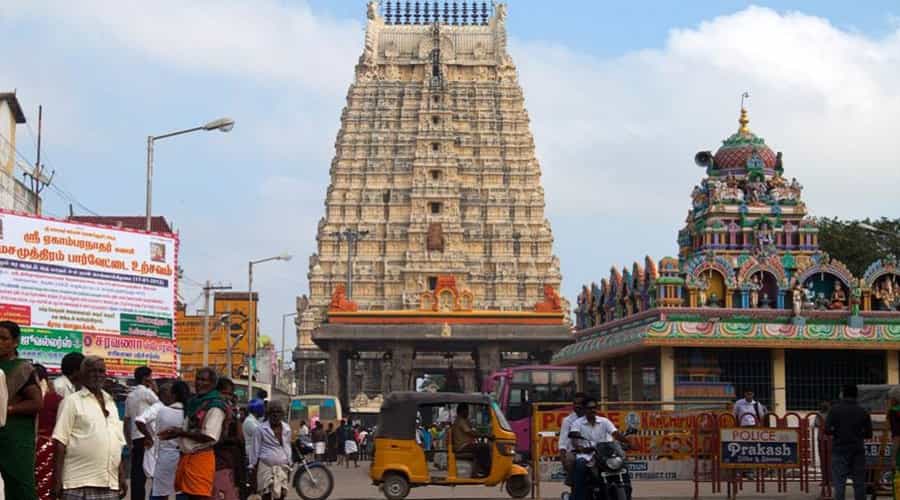
Kanchipuram in Mahabalipuram is located nearly 70 kilometres to the southern part of Chennai. Kanchipuram is also known as “The City of thousand temples”. The prime attraction of this place is The Ekambareswarar Temple. The popular Advaita Philosopher Shankaracharya preached his teachings at this famous place. The maximum temperature is 37C and falls down to minimum of 20C. The average population of this place was more than 30.38 lakhs when calculated in 2001 census. The total area of this amazing place is 116.6 sq. kilometres. Kanchipuram is an essential part of the Golden Triangle present in south India.
Kanchipuram is considered to be one of the most sacred cities among the famous seven holiest cities in India. Kanchipuram in Mahabalipuram is net to Varanasi in terms of popularity and is very important among the devotees. Kanchipuram stayed to be the capital of many dynasties which ruled this place successively. The Pallavas and the Cholas along with the Rajas of Vijayanagar all have ruled Kanchipuram. The Pallavas who ruled Kanchipuram form 6th century to 7th century erected these magnificent temples. Tourists from India and abroad, love to visit this place and encounter a new kind of adventure.
Kanchipuram takes 5 hours from Mahabalipuram. You can easily plan out your tour to Kanchipuram in Mahabalipuram. You can leave from Mahabalipuram early morning and reach Kanchipuram which was once known as Golden City of India. You can visit the Shiva Kanchi and Vishnu Kanchi temples in Kanchipuram which have historical relevance. The global map is accessorised with this astonishing city. The diverse and amazing architecture of this place is have made remarkable note in the history of south India. This place is also blessed with a sacred mango tree which is known to be as old as 3500 years old.
Krishna Temple In Mahabalipuram
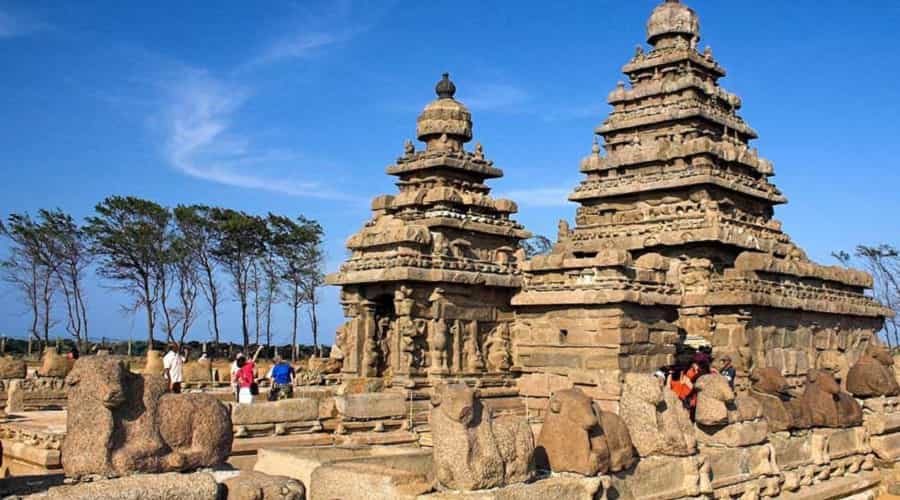
Among all the famous temples present, Krishna Temple in Mahabalipuram is the biggest of all. This temple is devoted to Lord Krishna who is a famous figure of many mythological Hindu stories. The temple is bestowed with amazing architecture and it is quite fascinating watching the temple when you visit the interiors. There are various sculptures present inside the temple which depict the stories of Lord Krishna when he was in his adulthood. The sculptures sing and dance to the brave and energetic stories of the Lord. You can all the stories related to his lifecycle. In one of them is lifting the huge mountain of Govardhana on his little finger and elder this to provide shelter to all the residents and animals of the town from rain.
Then there is a sculpture pictures Lord Krishna stealing curd and sharing it with his friend and many others. Because of its utterly beautiful sculptures the temple has gained a lot of popularity. However the main theme of Krishna Temple in Mahabalipuram is the incidence of Krishna lifting the Govardhana. The whole temple is sculpted and engraved on this theme and there are lot of sculptures based on this occurrence. Every year many people come to witness the worship carried out in this temple in the spring season. Since this temple is the symbolic of the worship and offerings done for the mount Govardhana, on the day of Govardhana puja, the temple is decorated on a large scale and prayers and offerings are made whole day.
The Krishna temple in Mahabalipuram is based on the story of Lord Krishna saving the people from the anger of Indra the god of rain. Indra ordered the clouds to pour heavy rainfall in the city of Gokul as the residents were told by Krishna not to worship him but worship the mount Govardhana.
Mahishasuramardini Cave In Mahabalipuram
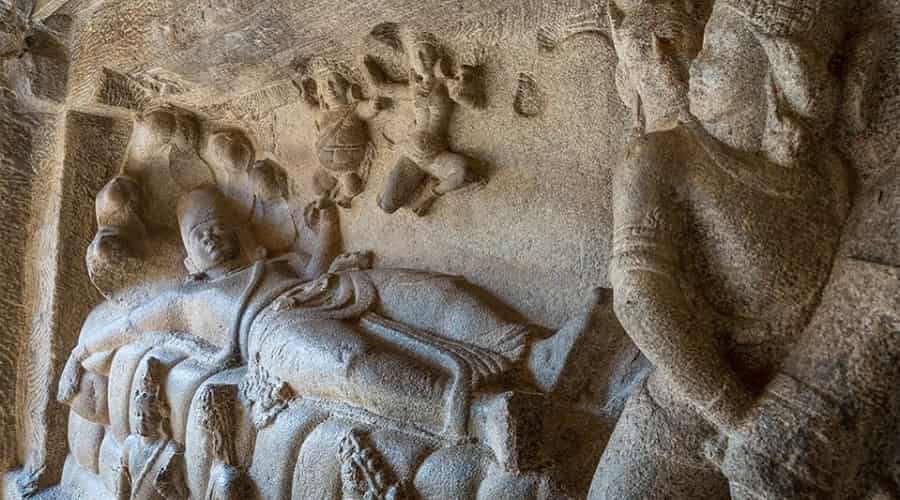
Mahabalipuram is a city of beautiful rock cut temples. There are nearly 10 most important caves in this city which have marvellous architecture and are a true representation of Indian Style of monuments. However, among all the cave temples, Mahishashurmardini Cave in Mahabalipuram is the finest example of beauty and serenity. You will reach the state of tranquillity as soon as you witness the temple. The very first glance of the temple is ultimate soothing and calming. This rock-cut temple was made in middle of the 7th century and is sanctified with the diet Goddess Durga who kills Mahishasur who was a devil.
The temple is famous for its bas- reliefs which are very fine and these reliefs are made on the panels of the cave. These reliefs have enduring beauty and are of great significance. One side of this attractive cave is bestowed with a sculpture of Lord Vishnu who is having as cosmic sleep and the other side of the wall depicts the fight between Goddess Durga and the demon. The sleeping posture of Lord Vishnu is very serene and fills you with peace at heart. The Mahishasuramardini Cave in Mahabalipuram also consists of a sculpture of Somaskanda present in the temple glows with power and peace along with wisdom. There is a Dhwani which is known as the art of suggestion, present in the temple which shows the omnipresence of Lord Vishnu and hence is of great worth.
The temple was erected by the Pallavas and each and every engraving chiselled in the cave shows the hard work and expertise of the artisans of that era who have created this masterpiece which has now turned into Mahabalipuram tourist attractions. The opposite wall of the Mahishashurmardini Cave in Mahabalipuram is endorsed with a wall that is having a huge exaggerated panel which seems very unrealistic. This panel is beautifully sculpted with the description of fight of Goddess Durga with the demon and this episode is believed to be culled from a celebrated poem of Sanskrit known as Devi Mahatmya.
Panch Pandav Rathas In Mahabalipuram
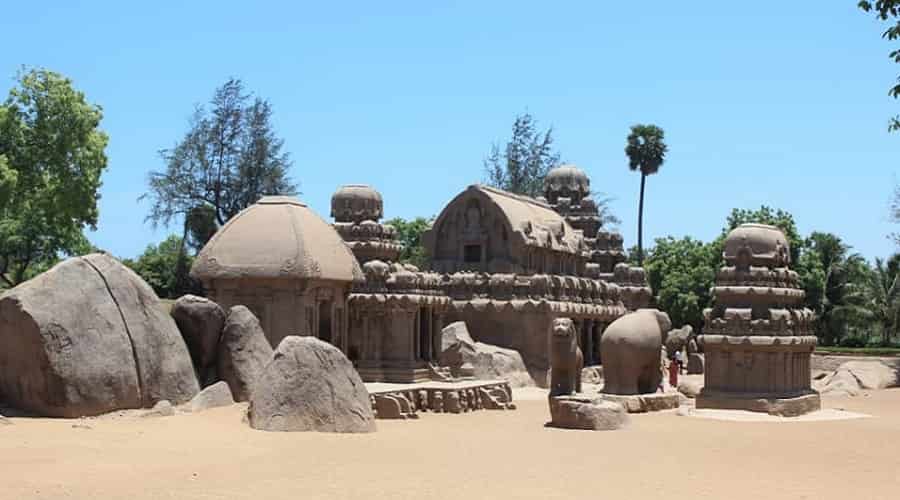
The Panch Pandava Rathas in Mahabalipuram is noteworthy of monolithic rock carved temples. The word Panch means five and is a Hindi symbolic of five. These temples are situated in the sandy compounds of the city and are the best example of the Dravidian form of architecture. However these are Hindu temples, the look like pagodas and are similar to the Buddhist monasteries and Shrines. Rathas are the chariots and these chariots are endowed with large towers and beautiful carvings. They represent the cars of the mighty gods and have large halls that are multi pillared.
The walls of these chariots are chiselled out very minutely and intricately and at the same time are highly sculptured. The Panch Pandava Rathas in Mahabalipuram has an ancient story behind them and is associated to the great Hindu Epic, Mahabharata. The story is related to the heroes of this Epic, the five Pandavas and their wife Draupadi and the Panch Pandava Rathas are constructed out to pay homage to these heroes.
Panch Pandava Rathas are made of five different temples. These temples are Draupadi’s Ratha for the queen of Pandavas, the Arjuna Ratha for Arjuna who was a great warrior, Nakul-Sahdev’s Rath for the youngest brothers, Bhim Ratha for Bhim who was a great wrestler and last one is the Dharmraja Rath for King Yudhistar who was the eldest brother. Due to their magnificence Panch Pandav Rathas attracts great number of tourists who come to visit Mahabalipuram.
Each of the Rath or temple in Panch Pandav Rathas in Mahabalipuram has its own significance. The Draupadi’s Rath is at the entrance of the main gate is the symbolic of Goddess Durga. It is protected and looked after by two female door keepers. The next one is the Arjuna’s Rath which is ornamented with the deity Lord Shiva. Then comes the Nakul-Sahdev’s Rath and is dedicated to the God of Rain- Lord Indra. The third Rath laid among the Panch Pandav Rathas is the Bhim Rath.
Shore Temple In Mahabalipuram
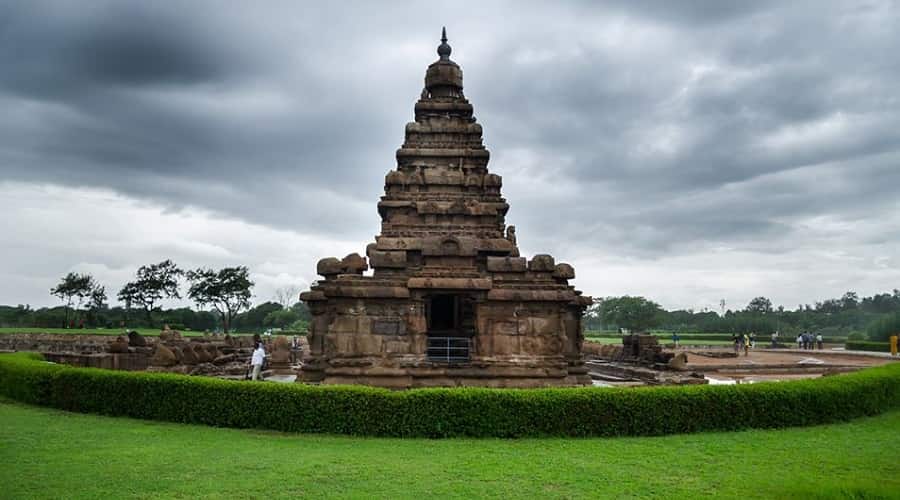
Many people believe that there were nearly seven Pagodas which were the seven temples and were located on the sea shore but all of them have immersed down in water. Out of the seven temples, only shore temple in Mahabalipuram represents the history of those seven pagodas. The shore temple was built in 7th century and later the remaining work was completed by Narasimha Varman II. He took care of all the measures that were needed for the skilled architecture of this temple.
Among all the south Indian temples, shore temple is the oldest one which is erected in the original Dravidian way. It has happened so because the temple got enlisted in the heritage sites of the world by the UNESCO. This has increased the popularity of this temple. The temple is blessed with two temples having the Lord Shiva as the deity. Both the temples face the east as well as the west directions. The there is a Vishnu temple which enhances the beauty of shore temple in Mahabalipuram.
It should be noted that Vishnu temple was constructed by Narasimhavarman I however the other two temples of Lord Shiva were erected by Narsimha Varman II. The Shiva temples which are endorsed with Dwarka Palakas or gate keepers who are carved at the entrance gates of both the temples.
These gate keepers are believed to take care of the temple. The immensely beautiful sculptures of Lord Vishnu and Lord Brahma along with their cohorts are mounted inside the temple. However the upper part of the Shivalinga inside the temple is much damaged, there are other figures f Shiva along with his wife Parvati and both his sons Ganesha and Skanda.
All along with Lord Shiva, there are also sculptures of Goddess Durga and the reincarnation of Lord Vishnu, Narsimha in the shore temple in Mahabalipuram. There is a magnificent sculpture of Lord Vishnu which is commonly known as Ananthasayana. This statue represents the sleeping pose of Lord Vishnu.
Tiger Cave In Mahabalipuram
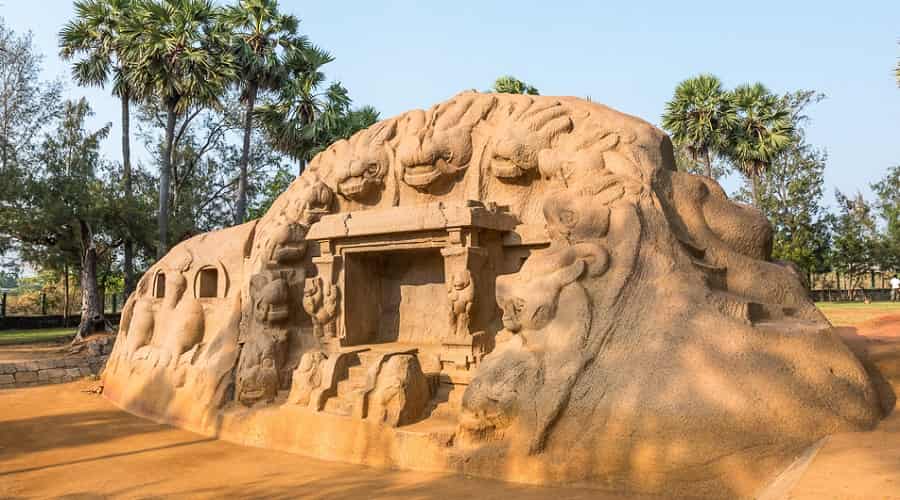
Mahabalipuram is a city which is well known for its temples. The temples of this city are stupendous and the architectures of these temples represent the skills of the artisans of different dynasties. Mahabalipuram has been the main workplace of the Pallava dynasty and the Pal lavas art present in each and every corner of this city accentuates on the beauty of earth and life. Among the beautiful temples of this place, Tiger Cave in Mahabalipuram is among the best example of the Pallava architecture. If you travel nearly 4 kilometres in the north direction from the main complex, you will reach Tiger Cave.
Tiger Cave in Mahabalipuram is situated near Saluvankuppam village which is a coastal village in real terms and perched on the Kovalam Road. This glorious temple comprises of many shrines which are constructed in devotion to Goddess Durga. The front area of the temple is imparted with big and beautiful figures. The temple encompasses the sculptures which pasteurize the battle of Goddess Durga with the devil or Rakshasa Mahishasura. The Goddess got angry on the devil and killed him with her mighty weapon. This sculpture depicting the killing of Mahishasura is located on the front part only.
Mahabalipuram known as Mahishasuramardini Temple also has some sculptures resembling these. The Tiger Cave in Mahabalipuram derives its name from the tiger that was the pet of Goddess Durga. If you move further more in the south direction of Tiger Cave, you would come across Athiranachandra Temple which acquires a huge figure of Somaskanda.
It is said that this temple was built in the form of an open air theatre to perform various cultural programs in the Pallava Period, however these days nobody even cares to look after it. Though the temple is located near sea, it attracts a huge number of tourists and is among the favourite Mahabalipuram tourist attractions.

 Call
Call WhatsApp
WhatsApp Enquiry
Enquiry